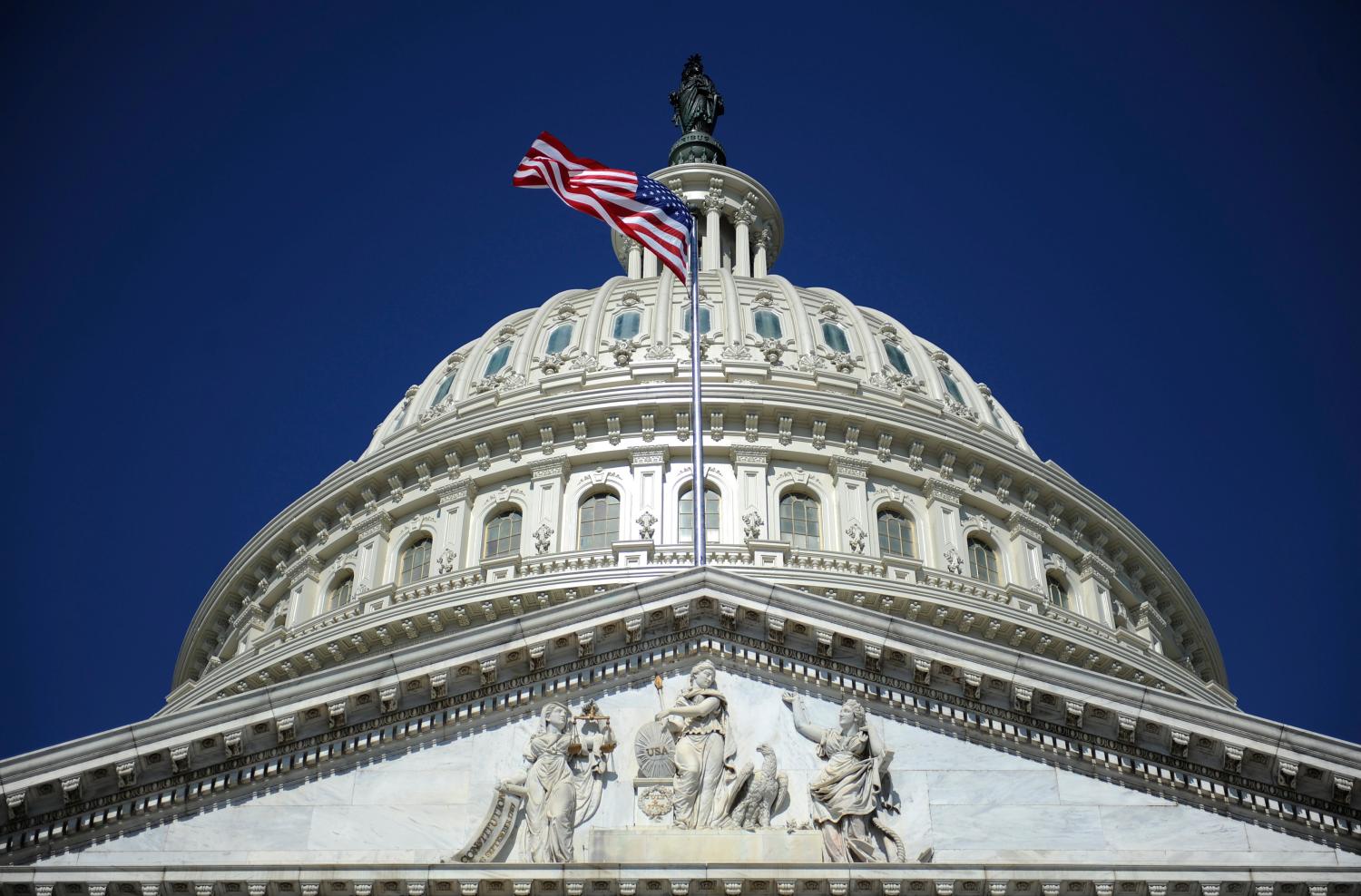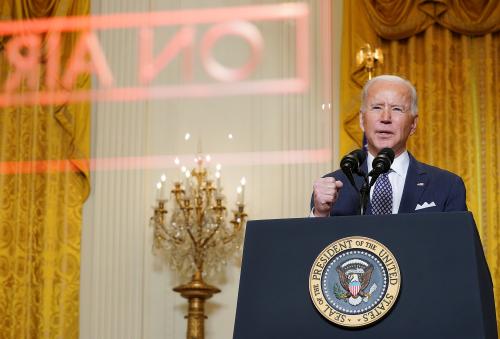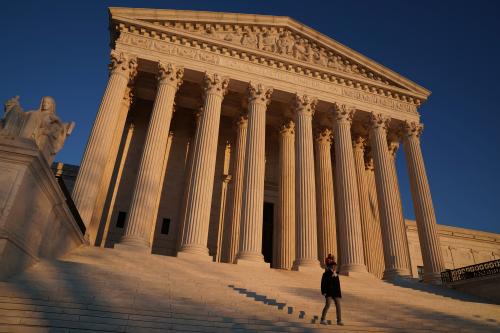One sign of a healthy democracy is a judiciary that applies the law independently, even in cases involving powerful partisan interests. When President Donald Trump tried to enlist the courts in his campaign to overturn the results of the election, state and federal judges applied the law as they understood it. They did so despite Trump’s history of lashing out at judges who crossed him during his 2016 campaign and later.
Trump’s election litigation efforts failed decisively, even though more judges than is generally assumed found his lawyers’ arguments persuasive.
Despite his judicial failures—and unlike autocratic executives who have tried to silence independent judges, such as Hungary, India, and Poland—Trump apparently did not try to intimidate judges as he did state election officials. That does not mean he will be silent during litigation over future elections, especially if, as is likely, that litigation is less slap dash than the challenges in 2020.
Introduction
USA Today provided the conventional assessment of those challenges: “Out of the 62 lawsuits filed challenging the presidential election, 61 have failed,” and “decisions have came [sic] from both Democratic-appointed and Republican-appointed judges.” (In fact, most of the judges were elected state judges.)
One victory out of 62 cases is about a 1.5% win rate. Looked at differently, as I do in this post, Trump performed slightly better. This post examines all judicial decisions in the cases, not just the cases’ ultimate outcomes. A case might produce an initial decision in a trial court, another set of votes on appeal to a multi-judge intermediate appellate court, and a final set of votes on appeal to the jurisdiction’s multi-judge supreme court—one case, but perhaps over 10 separate judicial votes. By that measure, 14% of judges’ individual decisions or votes—18% in state cases only—were favorable to Trump.
Table 1: Individual judicial decisions (votes) in 2020 presidential election case
| State | Federal | Both | |
|---|---|---|---|
| For Trump | 27 (18%) | 1 (2%) | 28 (14%) |
| Against Trump | 123 (82%) | 43 (98%) | 166 (86%) |
| Total | 150 | 44 | 194 |
Methodology
Counts of 2020 election lawsuits vary. Democratic election lawyer Marc Elias’s election litigation website listed 69 cases in early November 2021, up from 62 in January. Other sources include fewer cases. A February Business Insider article reported “at least 42 legal challenges since election day,” while Ballotpedia and Wikipedia summarized 36 and 55 cases, respectively.
For this post, I drew the cases and their underlying orders and opinions from the Elias website, Ballotpedia, and Wikipedia. I excluded cases commenced before the election; cases that only contested legislative races; and cases that plaintiffs dropped before any judicial action. I counted only votes on the final decisions at each level, not every judicial decision—such as those on non-dispositive procedural motions and the like. (Obviously, different selection criteria would probably produce different percentages than those reported here.)
This resulted in the examination of 194 judicial votes in 42 post-election cases:
- 29 state cases with 150 votes by 75 judges, and
- 13 federal cases with 44 votes by 41 judges.
I coded these votes by a simple binary measure—Trump won, or Trump lost. For sure, a judge’s decision—many involved jurisdictional or procedural questions—is not necessarily an indication of the judge’s view of Trump’s basic claim of election fraud. Rep. Jamie Raskin’s (D-Md.) was at best imprecise when he told the House in October that the election “was validated by more than 60 Federal or State courts … all of them rejecting every claim of electoral fraud and corruption that was advanced.”
Federal judges
Of the 44 votes (in 13 cases), only one vote favored Trump—and did so just barely. (Note: The 13 cases include the U.S. Supreme Court’s rejection of Texas’s original jurisdiction filing challenging other states’ election results, but not the several nine-vote certiorari denials. Also excluded is a District of Colorado case included in none of the three sources above. It alleged a “vast [four state election] conspiracy;” the magistrate judge dismissed it for lack of jurisdiction O’Rourke et al v. Dominion et al (April 2021) and later assessed significant attorneys’ fees.)
Table 2: Federal judicial decisions (votes) in 2020 presidential election cases
| R appointee | D appointee | Total | |
|---|---|---|---|
| For Trump | 1 (3%) | 0 (0%) | 1 (2%) |
| Against Trump | 29 (97%) | 14 (100%) | 43 (98%) |
| Total | 30 | 14 | 194 |
In a Georgia case, the district judge (a 60-year-old George W. Bush appointee) granted plaintiffs’ request for an emergency temporary restraining order to preserve ballots in a subset of 10 contested counties. But the plaintiffs, in the words of a Trump-appointed circuit judge, refused to “take the district court’s ‘yes’ for an answer.” It appealed the district judge’s action to ask the court of appeals to extend the order to all 10 counties. The appellate panel dismissed the appeal.
The 13 federal cases saw votes by 12 Trump appointees, none of them favorable to Trump.
State judges
The state-court litigation in my database occurred in seven of the battleground states in which Trump and allies filed litigation; pro-Trump votes occurred in three of those states.
Table 3: Judicial votes in 2020 presidential election cases, by state
| Wis. | Pa. | Mich. | Ga. | Ariz. | Minn. | Nev. | Total | |
|---|---|---|---|---|---|---|---|---|
| For Trump | 12 (39%) | 10 (29%) | 5 (16%) | 0 (0%) | 0 (0%) | 0 (0%) | 0 (0%) | 27 (18%) |
| Against Trump | 18 (61%) | 24 (71%) | 27 (84%) | 19 (100%) | 15 (100%) | 5 (100%) | 15 (100%) | 123 (83%) |
| Total | 30 | 34 | 32 | 19 | 15 | 5 | 15 | 150 |
State-court level
The 29 state cases did not all begin in the first instance (trial courts). Several times, for example, plaintiffs sought to invoke an appellate court’s original jurisdiction.
Table 4: Judicial votes in 2020 presidential election cases, by court level
| First Instance | Intermediate appellate | Supreme court | Total | |
|---|---|---|---|---|
| For Trump | 0 (0%) | 6 (40%) | 21 (17%) | 27 (18%) |
| Against Trump | 20 (100%) | 9 (60%) | 94 (83%) | 123 (82%) |
| Total | 20 | 15 | 115 | 150 |
Most pro-Trump votes came in dissents in the multi-judge appellate courts. These judicial disagreements might reflect the fact that appellate judges often dealt with less frequently litigated questions, such as those involving appellate courts’ original jurisdiction, and appellate judges, in any event, may regard themselves as less bound by precedent than first-instance judges.
State-court partisan variations
Thirty-five percent of decisions by Republican-affiliated state judges were for Trump, versus 2% of decisions by Democratic-affiliated judges. Put differently, almost two-thirds of the 75 votes by Republican-affiliated state judges votes did not support Trump’s claims, although 26 of the 27 pro-Trump votes in my cases came from judges with Republican party affiliations. (Judges whose affiliation I could not establish provided no support for Trump.)
Table 5: Judicial votes in 2020 presidential election cases, by judges’ perceived party affiliation
| Republican affiliation | Democratic affiliation | Not known | Total | |
|---|---|---|---|---|
| For Trump | 26 (35%) | 1 (2%) | 0 (0%) | 27 (18%) |
| Against Trump | 49 (65%) | 51 (98%) | 23 (100%) | 123 (82%) |
| Total | 75 | 52 | 23 | 150 |
I determined current or pre-judge party affiliation using Ballotpedia’s state-court assessments and standard internet searches. I assigned a “not known” label when I could not be reasonably sure of a current or former party affiliation.
Age
Younger judges, with an eye to advancement up the judicial ranks, might tailor votes to appeal to appointers or voters—more so than judges not looking for promotion. The data do not indicate younger judges’ doing so in these litigations. Twenty-two percent of state judges 55 or younger cast a pro-Trump vote, as did 25% of those over 55.
A closer look at state judges’ votes favoring Trump’s claims
Intermediate appellate courts
All six votes that state intermediate appellate court judges cast for Trump came from Republican-affiliated judges, five of them on Pennsylvania’s Commonwealth Court, one of that state’s two intermediate appellate courts. Most were dissenting votes, but in one dispositive ruling—Trump v. Boockvar, Nov. 12, 2020—the then-president of that court, sitting alone, set aside a small number of votes based on flawed guidance regarding a deadline for verifying voter identification. This is apparently the one frequently cited Trump litigation victory.
State supreme courts
Twenty-one of the 27 Trump-favorable votes came from dissents on the seven-member supreme courts of Wisconsin, Michigan, and Pennsylvania—10 cases in all. Trump lost all 10. All but one were split decisions—five of the 10 were four-to-three—largely but not exclusively along party-affiliation lines. Democratic-identified justices cast 35 of the 49 votes against Trump, Republican-identified justices cast 20 of the 21 pro-Trump votes.
The Wisconsin Supreme Court—despite a four-three conservative justice majority—decided four cases against Trump, all by four-to-three margins. A justice chosen in the state’s 2019 nonpartisan elections and seen as a stalwart of the court’s conservative bloc voted each time against the Trump campaign’s filings. The four-justice majorities in three cases declined the Trump campaign’s request to invoke the court’s original jurisdiction to allow the campaign to contest certain ballots (Trump v. Evers, Dec. 3, 2020, and Wisconsin Voters Alliance v. Wisconsin Elections Commission, Dec. 4, 2020) and a request to block the certification of the state vote (Mueller v. Jacobs, Dec. 3, 2020). The same four-justice majority on appeal rejected as untimely plaintiffs’ claims of voting irregularities (Trump v. Biden, Dec. 14, 2020).
The Pennsylvania Supreme Court, elected on a partisan ballot, had (and still has) a five-member Democratic majority. The five Democrats reversed a Commonwealth Court decision invalidating an executive official’s directive on poll-watchers’ distance from voting operations (In Re Canvassing Observation, Nov. 17, 2020). A four-justice majority (one Democrat dissented) affirmed a trial-court decision allowing officials to count otherwise qualified mail-in or absentee ballots lacking certain information on outside envelopes (In Re Canvas of Absentee Ballots and here, Nov. 23, 2020). The court, unanimously as to its main holding, reversed an emergency injunction suspending elector certification (Kelly v. Commonwealth and here, Nov. 28, 2020).
Michigan Supreme Court justices are party-nominated to run in nonpartisan elections. During the 2020 election litigation, it had four Republican-affiliated and three Democratic-affiliated members. A majority of three Democrats and one Republican dismissed, without briefing and oral argument, plaintiffs’ efforts to invoke the court’s original jurisdiction to order an audit of votes (Johnson v. Benson, Dec. 9, 2020). A six-justice majority, with one Republican dissenting, denied as moot an appeal’s request for an immediate, limited audit of votes (Costantino v. Detroit, Nov. 23, 2020). And the court unanimously rejected as moot an appeal contesting the certification of electors (Trump v. Benson, Dec. 11, 2020).
Most of the decisions were over points of procedure and jurisdiction, although, decided differently, some might have led to electoral reversals. There is nothing to suggest that the dissents were pretextual, although some justices voiced concern about the legitimacy of the election. A Republican-affiliated Michigan justice, for example, while concurring (in Costantino) that the plaintiffs’ immediate claim was moot, nevertheless referred to “the troubling and serious allegations of fraud and irregularities asserted by the affiants offered by plaintiffs.”
THE AFTERMATH
Although Trump had more judicial support than “one victory out of over 60 cases,” he lost all but one case—and the great majority of judicial votes in all cases disfavored his claims.
Nevertheless, Trump and his allies have not—to the best of my knowledge—sought to punish the judges who rejected his election-manipulation litigation, even though Trump was not reluctant to attack federal judges who crossed him during his initial presidential run or as president. Trump and allies haven’t advocated impeaching federal judges or eliminating their good-behavior tenure. Nor have I seen reports of hostile phone calls to judges—similar to those made to state election officials cajoling them to support his claims of fraud.
Nevertheless, the Republican-dominated Pennsylvania Legislature introduced a since-shelved post-litigation proposal to have members of the state’s Supreme Court selected from geographic districts. Although six states—ranging from Maryland to Louisiana—select high court members from districts, opponents of the Pennsylvania plan argued that it was a backdoor way to weaken Democratic dominance on the court and allow more legislative manipulation than other states’ methods.
WHAT MAY BE AHEAD
Clashes over the judicial response to Trump’s claims may be part of upcoming judicial elections, including efforts to seat more judges who would be receptive to fraud claims. An October 2021 Wall Street Journal editorial supporting a Republican candidate for an open Pennsylvania Supreme Court seat argued, “After Pennsylvania’s 2020 election mess, the state Supreme Court needs an injection of judicial restraint.” (The Journal’s chosen candidate, who said flatly that he saw no evidence of significant fraud in 2020, won the election.)
By a rough count, about half of the 43 state supreme court justices who considered Trump’s post-election claims (in all seven states) are slated to appear before voters by 2026—years likely covering the next presidential election and post-election litigation. Candidates will be free, under a 2002 U.S. Supreme Court decision, to tell voters how they view judges’ roles in election disputes and their views of the 2020 litigation.
Election volitivity could be enhanced if Trump, unlike during the recent litigation cycle, injects himself into campaigns to unseat judges who rejected, or express skepticism about, election fraud claims.
Furthermore—regardless of judicial selection outcomes—judges may be more receptive to electoral challenges in 2024 if state legislatures embrace the “independent state legislature doctrine.” Republican state legislatures are pointing to the Constitution’s Articles I and II provisions that authorize state legislatures to prescribe methods for selecting presidential electors. Also, legislatures may try to use a federal statutory provision to substitute their preferred slate of electors for those chosen by voters. Election expert Richard Hasen opines that, to the degree that the 2024 election turns on use of these provisions, post-election litigation advocates will “have an aura of respectability and expertise. Lawyers in fine suits making legalistic arguments are much more appealing than desperate lawyers making unsubstantiated claims of ballot box stuffing and other chicanery.”
In short, although Trump clearly lost the 2020 election litigation battle, he received more judicial support than generally realized. That and other factors may suggest rosier prospects for him in court battles over the 2024 election.
The Brookings Institution is committed to quality, independence, and impact.
We are supported by a diverse array of funders. In line with our values and policies, each Brookings publication represents the sole views of its author(s).








Commentary
Trump’s judicial campaign to upend the 2020 election: A failure, but not a wipe-out
November 30, 2021